How advances in technology are impacting the access sector
05 August 2021
No matter the size or scope of your business, there is no denying now is the time to adapt to today’s technology. Lindsey Anderson unwraps the latest tech, and explains the importance of timing.
Autonomous equipment. Connected jobsites. Data. Internet 2.0. IoT. Sensors. Telematics. Touchless transactions. Do these all sound familiar? Today’s construction site, and its equipment and rental providers, are not what they were 10 years ago. And they are not ever going to be what they were 10 years ago.
Our industry of access and telehandler manufacturers, equipment rental companies and contractors has slowly adapted from pushing paper to utilizing screens and digital means. Yet for every company that has embraced data tracking, telematics or mobile applications, there is a handful of stalwarts who have not.
For instance some pertinent questions are: Is your website responsive?; When was the last time your website was updated and modernized? Can potential customers access and easily view your products and services when on their mobile phones or tablets? Or does it look like it was built on Geocities?, and; Does your company have an active social media presence on Facebook, Instagram, Pinterest, Snapchat, TikTok, Twitter, YouTube etc?
In the grand scheme of it all, what technology have you adapted to benefit your bottom line?
If you are wondering why any of this matters, the answer is twofold. Technology allows companies to operate more smoothly and efficiently, saving money and time. As we look to fill the ever-increasing labor gap the industry needs to be cognizant of tomorrow’s workforce, their skillset and what will attract them to join your team.
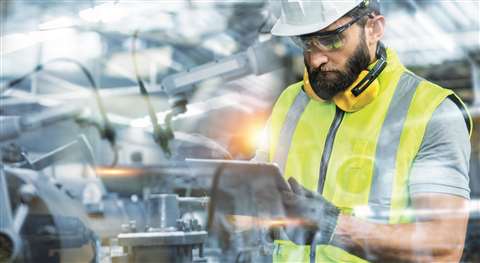 Utilizing control robotics aims to make industry more cost-effective, productive and improve safety
Utilizing control robotics aims to make industry more cost-effective, productive and improve safety
Future of the rental equipment industry
Take for instance the vast differences between Millennials and Generation Z. Millennials, who are now well into their 20s and 30s, came of age during the internet’s explosion – they were around the age of 10 when AOL started mailing compact discs to households and encouraging them to “get online”. Millennials never really had to adapt with technology because it was pretty much a norm in their lives. However, Generation Z (aka zoomers) were born into our uber-connected, high-tech and on-demand culture.
According to Pew Center Research reports, a Gen Zer utilizes at least five screens a day – from mobile phones and tablets to TVs and computers. If your means of record retention involve physical file folders and pencils then Generation Z does not want anything to do with you.
Tomorrow’s workforce is leaps and bounds ahead of the those who grew up building websites on Geocities. They know how to code, they can navigate any OS (operating system) and more importantly they not only want but have to utilize technology as they begin their careers.
Take, for instance, Wendi Smith who is an assistant service manager for Sunbelt Rentals in Ceres, California, USA.
An e-mail caught her attention so she clicked on the link out, and was rapidly transported into an immersive virtual world of access equipment.
Without leaving her desk she navigated onto a stadium jobsite packed with 3-D mobile elevating work platforms (MEWPs) and telehandlers.
From there she learned about equipment applications, drilled down into specs, watched walk-around videos, chatted with a product expert and, if she wanted, could order parts for her location’s rental fleet.
Smith was logged in to JLG’s “Access Your World” virtual experience, a dynamic, evolving environment designed to meet rental customers and equipment users where they are with information, education and training. It is free and can be accessed from any device.
Smith enthused, “It was hands-on and interactive. It took you right to the jobsite, and it showed how the equipment operates. It really helps, especially when you are talking to customers or placing orders to have that visual in your head of what exactly you need through the experience on the site. I loved it.”
This is just one example how tomorrow’s workforce, and jobsite, will look.
Jennifer Stiansen, director of marketing for JLG, “It’s really just the beginning when it comes to virtual learning experiences.
“We’ve seen the industry accelerate five years nearly overnight as it relates to the adoption of virtual. It became increasingly apparent that not only would we need to cater to this new medium, but we would also somehow need to break through the noise to get the attention of our audience.”
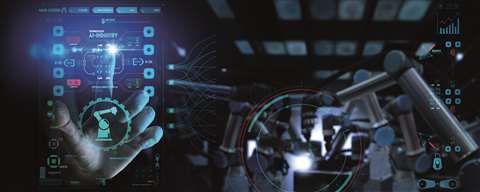 Artificial Intelligence (AI) is proving to be a powerful tool within many sectors across the world
Artificial Intelligence (AI) is proving to be a powerful tool within many sectors across the world
Construction’s technological advancements
Rob Messina, senior vice president of product development and product management with JLG, presented on future technologies at the ALH Conference in 2017. He showed the audience a video of an autonomous telehandler traversing a course with no operator, the machine utilized sensors to navigate the path.
Messina explained, “Despite how advanced this all seemed at the time, we are still quite some time out from seeing operator-less equipment on jobsites. The industry has progressed here in the form of trials and demonstrators that tackle real world jobsite challenges using autonomy.
“While we are not seeing fully autonomous equipment yet, we are seeing equipment that delivers moments of autonomy, though these are in their earliest stages.”
There is substantial observation at JLG happening at the jobsite level to identify the “jobs-to-be-done” that semi-autonomous and eventually fully autonomous equipment will be the solution for.
Yet Messina admitted, “There is still a lot of work to be done in this area before we see mainstream use of fully autonomous solutions.
“If we take a look at the auto industry, which construction generally follows, we see the integration of more and more sensors from luxury to value-based models. This increases the volume for sensing technologies, making it more affordable and accelerates the adoption curve in adjacent industries.
“Since the original presentation I gave in 2017, technologies such as object detection sensors, back-up cameras, and seatbelt/lanyard attachment verification systems are being offered by select manufacturers as options.”
United Rentals provided a look into “The Construction Jobsite of the Future,” also in 2017 and noted that by 2040, “Jobsites will bear little resembles to what we know today.”
As the world’s largest equipment rental company, United Rentals predicted construction sites will be on “virtual grids” that are integrated with design software so that almost everything on site will not only be traceable but connected.
The company also said autonomous equipment will become more prevalent, workers could utilize ‘bionic exoskeletons’ to aid in physically challenging tasks, Augmented Reality (AR) and Virtual Reality (VR) systems will train employees, with the use of robots and drones to be greater than ever before. These are all factors that will not only attract tomorrow’s workforce but also retain them.
Messina pointed out, “We are within five to 10 years from a major turnover in the demographic of the construction site worker. That handoff is going to be to a generation that grew up with computers and smart devices equipped with touch screen technology, as well as just about any app imaginable to assist them in navigating every day personal and work tasks.
“The continuous evolution of equipment through innovative, integrated technologies will make MEWPs and telehandlers increasingly intuitive to use and operate. Technology will certainly play a part in building the next generation of brand loyalists.”
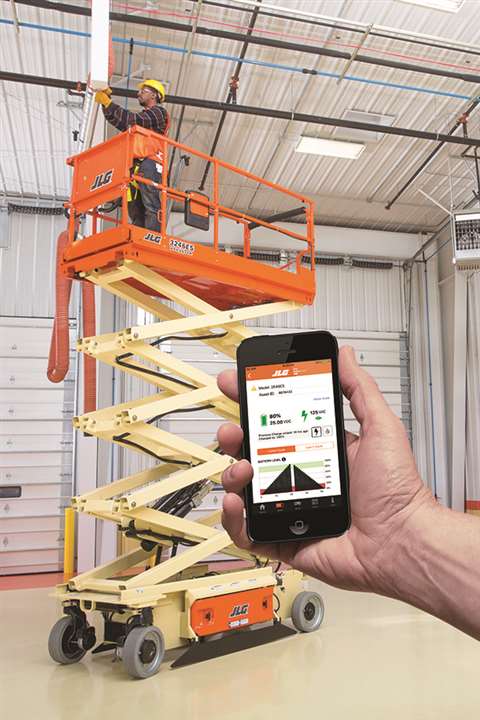 The JLG Advanced Battery Monitoring System analyzes the battery charge and usage for electric scissors and boom lifts
The JLG Advanced Battery Monitoring System analyzes the battery charge and usage for electric scissors and boom lifts
Digital business transformation
JLG’s “Access Your World” virtual experience was designed primarily as an educational tool for both rental companies and access equipment users.
The ability to connect with the multi-generational workforce for training resonates with Ryan Creighton, district sales manager for Herc Rentals in the northern New Jersey area.
Creighton said, “Many of our newer employees are not familiar with this equipment and how it can be used in real-life applications. It puts the application and gear associated with the work in better context.”
He believes that the pandemic exposed the need for the rental equipment industry to create more opportunities to engage in a non-traditional format.
Creighton added, “I am a Millennial, so I am very much aware of how the digital business transformation is happening.
“But during the Covid-19 pandemic we were all forced to connect and communicate from afar, I am interested to see the growth from here.”
David Boelke, an equipment sales consultant for Titan Machinery in Fargo, North Dakota, commented that JLG’s virtual experience is vastly different from other virtual gatherings.
Boelke said that the ability to be in control of the virtual environment allows him to interact with new equipment that he might not be familiar with, and educate himself to more effectively meet the needs of his end-user customers.
He explained, “I like the video game feel of the JLG “Access Your World” virtual experience. It has given me a better understanding of the equipment available to rent and sell.”
Benefits of Elevate Live technology
In 2020, Skyjack debuted Elevate Live – a new technology the industry hadn’t quite seen before that allows operators to have instant access to a machine’s health and status via a QR code. Operators simply scan the QR code with a mobile device and receive immediate information.
Mike Sheremeta, telematics business development associate with Skyjack, claimed that Elevate Live has helped rental companies overcome a number of obstacles.
He said, “Operators have the ability to see the status of machines and eliminate service calls. For example, the operator can now see if the starter battery is dead and can therefore avoid a costly service call.”
Further benefits of Elevate Live include operators having machine familiarization material at their fingertips, to actively see faults on machines and work with rental companies over the phone to resolve issues remotely that increases machine uptime.
Sheremeta added, “Elevate Live has been able to offer customers through telematics improved battery behavior, optimized maintenance planning, transparency through knowledge of how machines are being used on the field, decreased onsite visits, the ability to troubleshoot machines remotely, increased machine uptime and it promotes increased safety around jobsites.”
Another new technology that focuses on the rental side of business comes from Genie and its Lift Connect telematics system. Earlier this year, the company introduced Access Manager, a new feature that allows rental companies to have the capability to remotely manage access to their fleet and assign only authorized operators to a machine. This significantly improves the security of the equipment and teams on the jobsite.
Access Manager works by assigning a unique code, which can be randomly generated or personally selected, to an individual operator through the Lift Connect portal. That operator then can be assigned to specific equipment. The unit then can be started only when an operator enters an authorized code on the Access Manager keypad, or when they use an authorized Access Manager RFID card, which can be purchased separately.
Considering the jobsite use, the keypad of the solution has been designed with durable, highly tactile buttons that can be easily pushed even if the user is wearing work gloves.
Genie’s Anja Groebner, director for connected assets and value-added services, commented, “We have seen an increase in demand from our customers to monitor and manage aerial fleets remotely.
“A benefit of Genie Lift Connect is that it offers more transparency for our customers, providing greater understanding and an enhanced ability to turn data into action compared with offerings in the market. This is a clear advantage for our customers to maximize productivity and minimize downtime.”
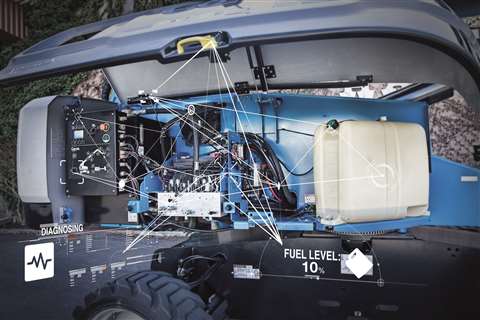 The Genie Lift Connect solution is a telematics program that provides information to monitor and manage aerial fleets
The Genie Lift Connect solution is a telematics program that provides information to monitor and manage aerial fleets
Impact of Trackunit telematics
The Ahern Family of Companies commenced a roll-out of Trackunit telematics across its rental business with immediate effect in 2020. The telematics program for Snorkel and Xtreme Manufacturing will be officially launched to its customers later this year.
Matthew Elvin, CEO of Snorkel and Xtreme Manufacturing, explained, “On the manufacturing side of our business, we have had a lot of interest already from our dealers and their customers across the world.
“A major benefit of working with a partner like Trackunit is that our customers can access telematics data for a wide range of equipment in a single, agnostic portal or utilize standard APIs feed data in their existing systems.”
Elvin commented that the basic requests they see in regard to data are location, operational hours, battery charge level on electric units and engine parameters and codes on diesel units.
He added, “Customers are appreciating knowing where the machine is located, especially on large jobsites. This greatly enhances being able to efficiently locate the unit for maintenance or transport.
“Additionally, especially in rental, understanding the hours being utilized on the unit opens the opportunity to additional rental fee if used over and above agreed hours.”
Pettibone’s X-Command platform unveiled
Telehandler manufacturer Pettibone introduced X-Command on August 1, 2021. The new telematics program is available for the company’s X-Series telehandlers, Cary-Lift pipe and pole handlers and Speed Swing rail maintenance machines.
The company disclosed that the system will offer real-time access to machine data. This is designed to save time, money and hassle for equipment owners, fleet managers, rental centers and maintenance technicians.
X-Command allows users to remotely track a machine’s location and observe data points such as engine hours, fuel rate and usage, diesel exhaust fluid level, battery voltage and more.
Pettibone claimed, “By obtaining accurate and current performance information, users will be able to quickly identify and address minor mechanical issues before they become serious.”
Equipment owners will be able to access data and generate reports using the online X-Command dashboard on their computer or mobile device. The platform will allow for quick and simple remote diagnosis of a telematics-equipped machine, potentially eliminating the need for certain field service calls. By ensuring maintenance is up-to-date, users can consistently increase equipment uptime and improve their overall return on investment.
X-Command will come standard for two years on new Pettibone X-Series Extendo and Traverse telehandlers, and it will also be available as a retrofit for existing X-Series models in the field. The system will be optional on new sales of Cary-Lift material handlers and on Speed Swing, the original do-it-all crane for the rail maintenance industry.
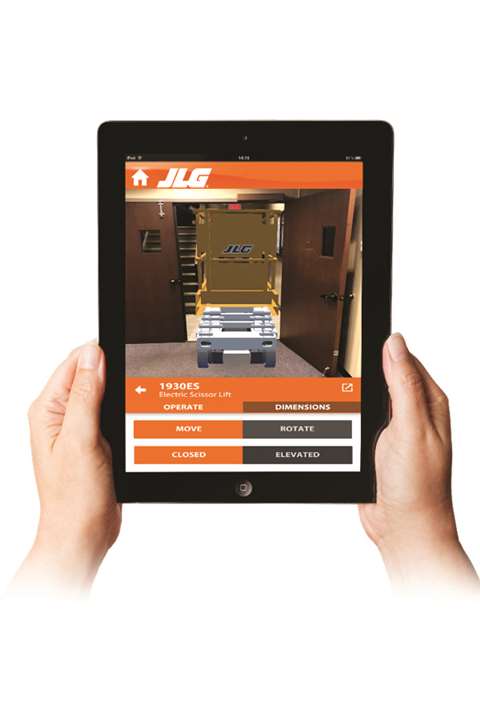 The JLG Augmented Reality (AR) app delivers data for onsite equipment management
The JLG Augmented Reality (AR) app delivers data for onsite equipment management
Live data to support strategic decisions
It goes without saying that all of this technology is propelled by data. Customers can request live data as a tool to help make better strategic and maintenance decisions. Data has been key to helping rental companies achieve a lower cost of ownership.
Messina said, “Telematics provide a wealth of data. That said, data can easily overwhelm a person and be rendered unusable if it is not easily digestible or the person on the receiving end does not have the time to analyze it and determine how to action it.”
Customers should ask for a means to collect and disseminate the data as well as a way to analyze and suggest actions based on the data that helps them to improve productivity, safety, maintenance, fleet management and the overall performance of their jobsites and business.
Messina pointed out, “Raw data in and of itself is no longer desirable.”
Ara Eckel, senior manager of connected solutions at JLG, stated, “One of the biggest benefits that we are hearing from the field about connected solutions is that it is helping our customers from being overloaded, and overwhelmed, by data.
“This is common when there is so much data available that a customer does not even know where to start to find the answers to the questions they have. With so much data at our fingertips today, it is become increasingly difficult to access the right information at the right time.”
Technology features and the productivity
According to Messina, the best way to help move the aerial industry forward is for the entire ecosystem, from manufacturers to rental companies to end-users and suppliers, to continually integrate new technologies into their everyday lives.
He said, “Embracing new technologies, despite the learning curve, will help accelerate adoption. This in turn will make new technologies more affordable.
“Take our consumer lives as an example. We are increasingly embracing connected technology. We have smart speakers, watches, refrigerators, thermostats, doorbells, lights and more. Our cars are mobile computers, collecting and sharing streams of data.
“The more people become familiar with technology features and the productivity benefits gained from them in their personal lives, the easier it will be to transition to incorporating similar connectivity on the jobsite.”
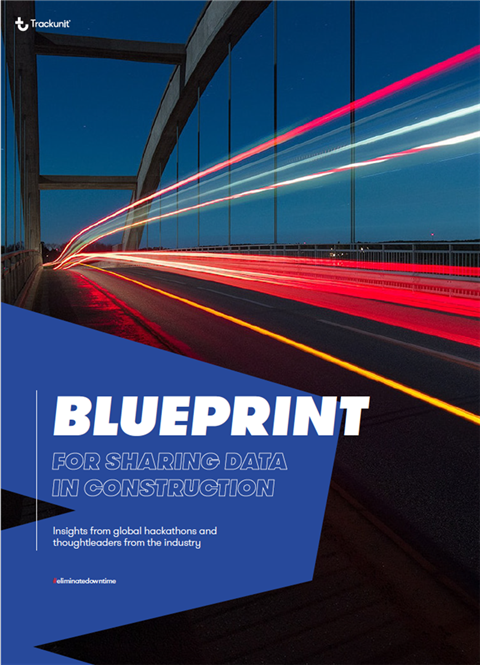
Trackunit published the “Blueprint for Data Sharing in Construction” in June 2021, which explores how data sharing can maximize productivity gains across industry applications and eliminate downtime.
The Blueprint is a curation of insights, concepts, use cases and value propositions from the industry to stimulate ideas around shared data and inspire new product and service innovation.
The report includes three parts, namely an introduction to Data Sharing in Construction, the Success Elements Framework and concludes with a chapter on actionable approaches allowing organizations to move data sharing forward.
Soeren Brogaard, CEO of Trackunit said, “We are at a unique place in time, where the adoption of digital technologies is making an increasing impact on the market.
“The Blueprint is our contribution to supporting companies and organizations in our industry to find a common language to talk about data sharing and explore opportunities for partnerships and business impact in an increasingly digitized market environment.”
Click here for free download of “Blueprint for Data Sharing in Construction”
Click here to view the video “Blueprint for Data Sharing in Construction”
Access, Lift & Handlers asked a handful of companies about data sharing.
Snorkel and Xtreme Manufacturing’s Matthew Elvin, CEO
“Data ownership and access to the data is really dependent on the local laws in place and the agreement between the parties who wish to have access.”
Skyjack’s Mike Sheremeta, telematics business development associate
“Skyjack recognizes that data comes from its customers’ machines, that customers own the data, and get to decide who, how, and when it’s accessed. From a product optimization perspective, it’s beneficial to both parties if rental companies allow Skyjack to view the data.
Most of Skyjack’s customers choose to share their data with the company, which is beneficial for them as Skyjack is able to see true job site usage and make data-driven design changes.
For example, Skyjack gathered detailed telematics data and engaged with customers to better understand opportunities for improvement before launching its new 40ft and 60ft booms earlier this year. The data helped Skyjack understand that its new models needed to employ smaller engines to avoid unnecessary costs while delivering the same on-site job performance as higher-powered units.”
JLG’s Rob Messina, senior vice president of product development and product management
“While no customer is required to provide equipment data back to the equipment original manufacturer (OEM), every OEM is interested in its’ customers sharing the information because of how useful it is for product development.
For example, shared data can help to improve, and sometimes reinvent, an OEM’s products, as well as to help develop new, more innovative equipment solutions in the drive towards tomorrow’s fully connected job sites and smart cities. That said, it is unlikely that universal data sharing will be easily achievable any time soon.
There is a tremendous amount of pressure to monetize data, and since there is no clear path to monetization, the uncertainly around this topic results in guarding one’s proprietary machine performance data. We believe the “how” will need to be solved before the industry will ultimately share data for altruistic purposes.”
STAY CONNECTED



Receive the information you need when you need it through our world-leading magazines, newsletters and daily briefings.
CONNECT WITH THE TEAM








